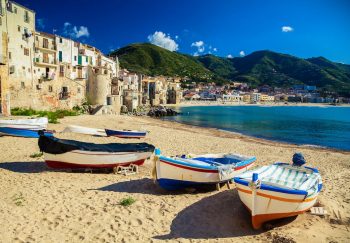Discover the freedom style of Sicily with us
The unique Italian art movement Liberty Style or Floral Style was created by Ernesto Basile and Giovan Battista Filippo. Liberty is an example of the new movement in Europe that has had an impact on art and took different forms in different countries. These are all related to the attitude to rupture and renewal that is assumed over previous art styles: Modern Style, Jugendstil Art Nouveau, Sezessionstil and modernism.
The Floral Style is inspired by nature’s organic shapes and colors and is applied to architecture and other minor arts. It is a design revolution which combines functionality and beauty with everyday objects. This is done by skilled craftsmen who can work with all kinds of materials, such as wood, gold and precious stones, wallpaper, fabrics and metals.
This new fashion was popularized in Palermo the capital city of Liberty style in Sicily. It was spread by a new entrepreneurial middle-class, of which the Florio were a major representative. They were able revive Sicily and launched it artistically and economically worldwide. Villa Igiea, Villa Ida, Villino Florio all’Olivuzza, chiosco Ribaudo, private buildings such as the Utveggio Castle, Villino Basile, Villino Favaloro, are masterpieces by Basile. Basile designed every detail to be consistent with the new Floral style. He was also close to Ettore de Maria Bergler and the Ducrot workshop for furniture, as well as many other artists-artisans like masons, foundry workers and goldsmiths. Basile’s artwork was a hit on windows, doors, facades, floors, walls, wallpapers and furniture. The main characters were calla lilies and gardens of irises, young maidens who became modern Botticelli Venuses, frames constructed out of branches and drooping clusters of leaves, graceful swans, magnificent peacock tails, and plants that gave the impression of never leaving the garden. They were able to give meaning to the idea of living in harmony and nature in an era so conditioned by industrial revolution.
Villa Malfitano was a home that the Whitaker family wanted between 1886-1889. It was designed by Ignazio Greco and features an intriguing “Summer” area. It looks just like a garden. It is by Ettore de Maria Bergler.
We are in the Belle Epoque. Walking through Notarbartolo and Freedom streets, or those in the neighbourhood Politeama, allows one to see the solid wealth, well-being, and optimism that swept Palermo during the early ‘900s, making it the main protagonist of the cultural and artistic phenomenon known as Liberty.
This phenomenon is widespread in Sicily.
Favignana is home to la Tonnara dei Florio. It is a testament of industrial archeology. In Trapani, there are the Poste e Telegrafo Palace and Villa Laura. Valderice has the Molino Excelsior.
You will find liberty style everywhere in Vittoria, including the Bruno di Belmonte Palace and the Piazzese Palace near Ragusa. You can also find the Musso in Pozzallo, and the Militello in Enna.
Licata is near Agrigento. You will find liberty style at Villa Sapio and Villa Urso as well as the Villa Verderame Palace, Vitello Palazzo, and in Casa Re-Grillo. V illa mari in Casteltermini was built in 1800. It is surrounded by beautiful parks and has an evocative Liberty Style appearance. The chapel attached to the villa has a mix of liberty and Moorish.
Catania had many decorators and craftsmen. However, the Liberty style was also influenced in part by Ernesto Basile. The Manganelli Palace was used as the setting for The Leopard by Luchino Viconti. The Sangiorgi Theatre, which is a complex building, also houses a cafe and a hotel. The Morano Palace is another Catania landmark. It’s decorated with floral patterns and female masks; the Palace at the Duca di Camastra Plaza, as well as the Mansion on Carmelo Abate avenue, and the Filangeri shop. Villa Ardizzone is designed in an eclectic-liberty fashion. The seductive Pink Palace, built by Fabio Maiorana (father of Ettore the physicist), is last.
The stunning stationof Taormina- Giardini building is in Liberty style. It has a central body and two floors. It is beautiful from the outside. We can see two towers and a canopy made of wrought iron. The interior rooms have furniture made of dark wood and ceilings decorated with frescos.
Ernesto Basile also designed the Officine Elettroniche located in Caltagirone close to the ancient monasteryof Santa Chiara. The Town Hall‘s back is in Liberty style. Liberty style is also used for the Poste e Telegrafi Pala, Casa Amico and Casa Quattro Stagioni di S. Fragapane. The Norman Church S. Giuliano was destroyed in the 1693 earthquake, but it has been rebuilt with the Liberty front.
Messina’s most prominent architects are Basile and Piacentini. The following buildings are Liberty-style: Villa Garner was built by Santacaterina in 1903. In the Liberty style, Villa Martines and Villino delle Rondini are famous for their ceramics depicting swallows. The Palace della Dogana and the Government House by C. Bazzani are all in Liberty style. Also, Ernesto Basile’s building of Banks and Savings, the Monumental Cemetery, and the Palace of Prefecture are all Liberty-style. Milazzo Villino Greco, Villa Vaccarino all in liberty style. They are located in the Vaccarella maritime district.











